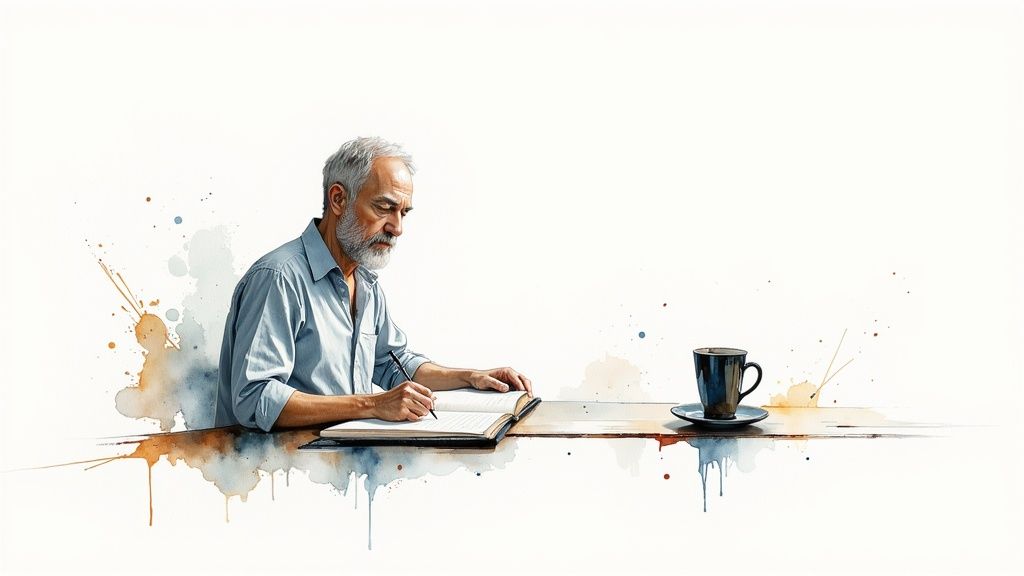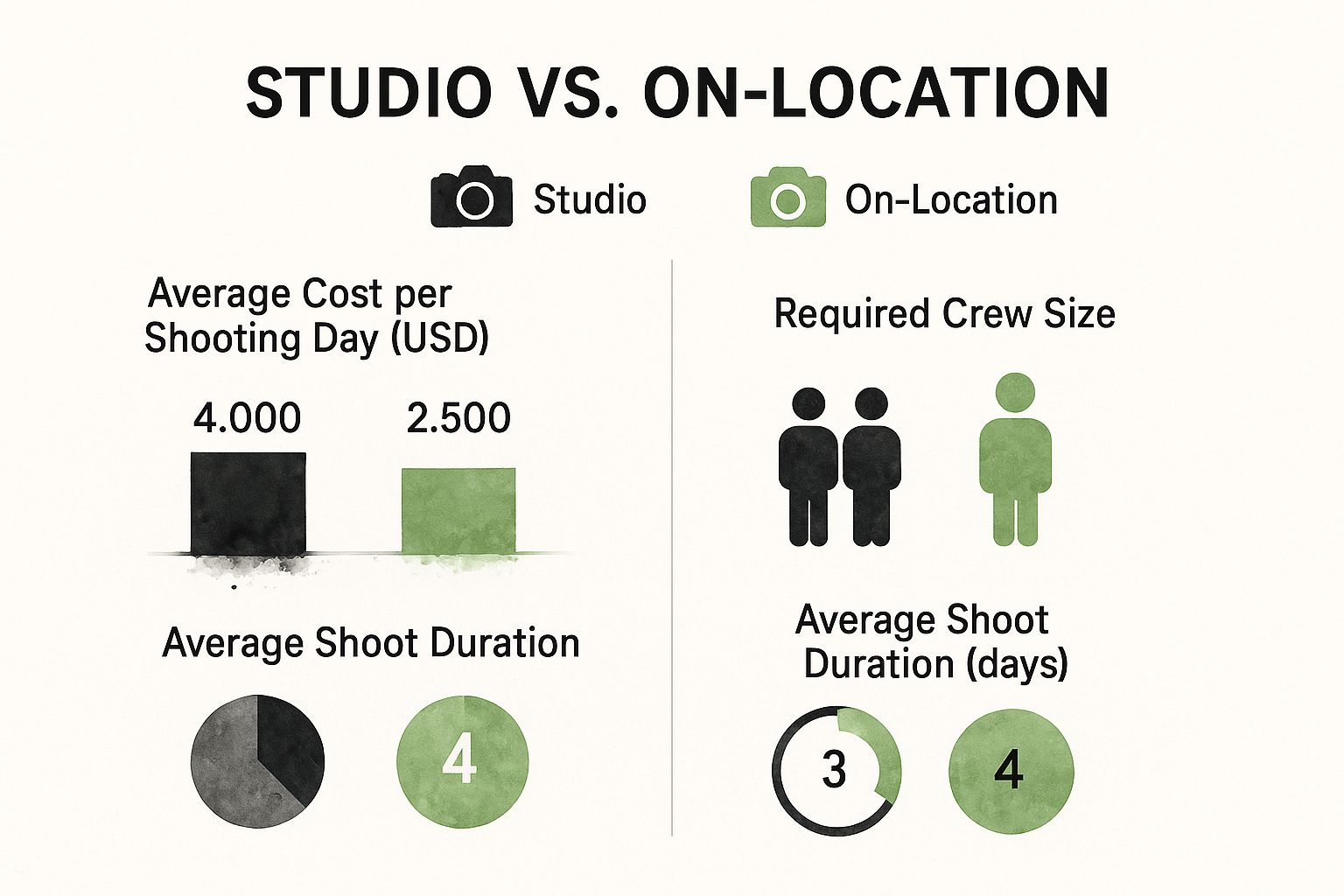Every video commercial, whether it’s a 15-second social clip or a Super Bowl spot, goes through four main phases: strategy, scripting, production, and distribution. Your success hinges almost entirely on that first part—the strategic foundation. This is where you figure out your audience and goals before a single camera starts rolling.
Laying the Groundwork for a Winning Commercial
Before you even dream about cool camera angles or finding the perfect actor, you have to build a solid strategic foundation. This is the blueprint for your entire project, making sure every decision—from the very first line of the script to the final cut—has a clear purpose.
Trust me, skipping this part is like trying to build a house without a plan. It gets messy, it gets expensive, and it almost never gives you the result you wanted. Getting this planning phase right is the single most important thing you can do to prevent costly mistakes and make sure your commercial actually works.
Define Your Core Objectives
First things first: what do you actually want this commercial to do? And no, "going viral" isn't a real business goal. You need specific, measurable objectives that will guide your creative team and let you know if you've succeeded.
Your goals might be things like:
- Boosting Brand Awareness: Getting more people in your target market to recognize your brand.
- Driving Website Traffic: Pushing viewers to a specific landing page.
- Increasing Sales: Directly promoting a product to drive immediate purchases.
- Generating Leads: Capturing email addresses or phone numbers for your sales team.
Thinking up the initial concept is where the magic begins; you can learn how to generate ideas that are both creative and on-brand. Once you have a clear objective, it becomes the North Star for every decision you make. For a deep dive into all the moving parts of pre-production, our ultimate video production checklist for 2025 has you covered.
Understand Your Audience and Message
Okay, so you know what you want to achieve. Now, who are you talking to? You need to go deeper than basic demographics like age and location. What are their real-life problems? What motivates them? What do they care about? A commercial selling a high-tech gadget to Gen Z is going to look, sound, and feel worlds apart from one selling retirement plans to Baby Boomers.
Once you’ve got a handle on your audience, you can nail down your unique value proposition (UVP). This is the one big idea that makes you stand out.
Your UVP isn't just what you sell; it's the specific problem you solve for your specific audience in a way your competitors can't.
Before you start production, it's essential to iron out these strategic pillars. The table below breaks down the core elements you need to define.
Core Elements of Your Commercial Strategy
| Strategic Element | Key Question to Answer | Example Outcome |
|---|---|---|
| Primary Objective | What is the #1 thing we want viewers to do? | Drive sign-ups for a free trial on our new landing page. |
| Target Audience | Who, specifically, are we trying to reach? | Millennial remote workers (28-38) struggling with project management. |
| Unique Value Prop (UVP) | Why should they choose us over anyone else? | We're the only project tool with a built-in AI assistant that organizes tasks for you. |
| Key Message | What is the one sentence we want them to remember? | "Stop managing your projects. Let our AI do it for you." |
| Distribution Channels | Where will this commercial be seen? | Paid ads on Instagram, LinkedIn, and YouTube pre-roll. |
Getting these answers down on paper transforms your idea from a vague concept into an actionable plan.
The advertising world is unbelievably crowded. Global ad spending is on track to blow past $1 trillion in 2025, and more than 75% of that will be digital. With that much noise, a fuzzy message just won't cut it. A sharp, targeted strategy is the only way to make an impact.
Crafting a Story That Connects

Alright, with your strategy nailed down, it’s time for the fun part: the creative. This is where you spin all that data and audience insight into a story that actually gets people to stop scrolling. The best commercials don’t just list features; they make you feel something.
Your job is to find that sweet spot where your brand’s message overlaps with what your audience is genuinely thinking about. What emotion are you trying to evoke? A good laugh? A moment of inspiration? A sudden urge to act? Pinpointing that emotional target is your north star for every line of dialogue and every single shot.
From Blank Page to Engaging Script
Writing for video is its own beast. You’ve got maybe 30 or 60 seconds to hook someone, introduce a problem, show how you solve it, and tell them what to do next. It’s a total sprint.
One of the biggest mistakes I see is trying to cram way too much information into a script. You have to be ruthless and focus on one single, powerful idea. If your product saves people time, show them getting their afternoon back. If it brings families together, create a scene that hits that emotional note. In video, showing is always more powerful than telling.
If you're looking for more advanced techniques, our guide on how to write a script for ads that actually converts is a great resource.
Sometimes, just getting started is the hardest part. Using a tool like Aeon’s AI script generator can be a fantastic way to kickstart the process. It can spit out a few concepts or lines of dialogue based on your core message, giving you a solid foundation to build on.
Visualizing the Narrative with Storyboards
Once the script feels right, don't jump straight to filming. The next crucial step is storyboarding. A storyboard is basically a comic-book version of your commercial, a sequence of sketches that maps out every shot, complete with notes on dialogue and camera movement. It’s the essential bridge from words on a page to a living, breathing video.
A storyboard isn’t about creating a masterpiece. It's a communication tool. It forces you to think through every camera angle, character movement, and scene transition before you spend a dime on production.
This process gets the entire team—from the director to the camera operator—on the exact same page. It’s also your last, best chance to catch problems while they’re still cheap and easy to fix. Notice an awkward transition? A shot that’s going to be a nightmare to film? Fix it now, on paper.

Think of the storyboard as the architectural blueprint for your commercial. It ensures the structure is sound before you start laying the bricks.
Bringing Your Vision to Life During Production

Alright, your script is locked in and the storyboard is ready. It's time to roll the cameras. The production phase is where all those ideas finally become tangible footage. I know this part can feel like a high-wire act, but if you break it down into manageable chunks—casting, location, and equipment—it's not nearly as intimidating as it seems.
Your first big task is getting your team together. This isn't just about finding talented people; it’s about finding the right people who actually get your brand’s voice and the story you're trying to tell. A great actor can make a flat script feel alive, and a skilled director will make sure every single shot serves the narrative.
Assembling Your Production Crew and Gear
First off, don't assume you need a massive, Hollywood-style crew. For a lot of commercials, especially those destined for digital platforms, a lean and mean team is often way more effective.
The absolute essentials? You'll want a director, a cinematographer (or a solid camera operator), and a sound mixer. If you're wondering how to keep a smaller production from going off the rails, our guide to mastering video production project management can be a real lifesaver.
When you're thinking about gear, put your money in these two places first:
- Great Audio: Look, viewers will forgive slightly grainy footage. They will not forgive bad sound. A quality microphone is completely non-negotiable.
- Good Lighting: This is what separates amateur-hour videos from professional-looking commercials. Lighting shapes the mood, tells the viewer where to look, and just makes everything look polished.
And you don't always need the most expensive camera on the market. Modern smartphones can shoot in beautiful 4K, and when you pair that with the right lighting and audio gear, you can get some incredible results on a tight budget.
The Importance of a Detailed Plan
On a film set, time is literally money. Every minute you spend trying to figure out what to do next is a minute—and money—wasted. This is why a detailed shot list and a realistic production schedule are your most valuable assets. A shot list breaks your storyboard down into individual camera setups, making sure you capture every single angle you need.
A well-planned production day is a calm production day. Your shot list isn't just a to-do list; it’s your roadmap that keeps the entire crew focused, efficient, and on schedule, preventing costly overruns.
This whole shift toward more agile, budget-conscious production is perfectly in line with what's happening across the industry. Digital video advertising is completely reshaping how commercials get made and where people see them.
In the U.S. alone, digital video ad spend is projected to rocket to $72 billion in 2025, growing two to three times faster than other media. That growth is being fueled by smarter targeting and performance metrics, proving that a well-made commercial on the right platform delivers a powerful return. You can discover more about video ad spend trends on iab.com.
Finding the Magic in Post-Production

The cameras have stopped rolling, but this is where your story truly comes to life. Post-production isn't just a technical step; it's where you meticulously shape raw footage into a cohesive, impactful commercial. This is where the real magic happens—where pacing, sound, and color come together to make people feel something.
Think of it this way: production gave you the ingredients. Post-production is where the chef gets to work. It all starts with organizing your clips and creating a "rough assembly," which is basically a first pass at stringing together the best takes in the right order. This initial cut is never pretty, but it’s the skeleton you'll build everything else on.
Shaping the Narrative in the Edit
Once you’ve got that basic structure, the real editing begins. This is all about pacing and making tough choices. Which take of that crucial line reading has the most impact? How long should you hold a shot to build suspense? An extra half-second can be the difference between a joke landing perfectly or falling completely flat.
Your job here is to guide the viewer's emotions. A rapid succession of short clips can create a feeling of energy and urgency, which is perfect for a product launch. On the flip side, longer, more deliberate shots can evoke a sense of calm or intimacy, ideal for a brand-focused story.
This is also where you’ll integrate any visual effects (VFX) or motion graphics. These elements should always serve the story, not just be there to look cool. For example:
- Subtle Text Overlays: Highlighting key features or a call-to-action without yanking the viewer out of the moment.
- Product Animations: Showing how a complex product works in a simple, visually engaging way.
- Scene Enhancements: Removing distracting objects or adding subtle effects to make a scene feel more polished.
The Power of Sound Design and Color
Sound is arguably 50% of the video experience, yet it's so often an afterthought. Great sound design makes your commercial feel immersive and real. I'm not just talking about dialogue; it’s about the subtle layers that bring a scene to life—the crisp sound of a soda can opening or the gentle hum of a city street in the background.
Music is your emotional shortcut. The right track instantly sets the mood, whether it’s upbeat and optimistic or dramatic and heartfelt. Take your time finding a piece of music that complements your story, rather than just plugging a hole.
Don't just edit what you see; edit what you hear. A commercial with polished visuals but poor audio will immediately feel amateurish. Clean dialogue, well-placed sound effects, and a fitting score are non-negotiable.
Color grading is the final artistic touch. It’s the process of adjusting the colors to create a specific look and feel. Do you want warm, inviting tones for a family-focused ad, or a cool, sleek palette for a new tech product? Consistent color grading makes sure your commercial looks professional and reinforces your brand’s visual identity.
Using a tool like Aeon’s AI editor can dramatically speed up this whole process. It can handle time-consuming tasks like initial color correction, audio cleanup, and even suggesting the best takes. This frees you up to focus on the creative storytelling that will make your commercial unforgettable.
Getting Your Commercial Seen by the Right People
You've poured your heart and soul into creating a fantastic commercial. But here’s the hard truth: a brilliant ad is completely useless if no one ever sees it. The final, and arguably most critical, piece of the puzzle is getting that video in front of the right eyeballs. Smart distribution isn’t about just blasting it everywhere; it's about maximizing your reach and return on investment by showing up where your audience already hangs out.
The advertising world has moved on. Digital is king, and it's projected to swallow up 73% of the total $1.17 trillion ad spend by 2025. While traditional TV still has its place, the explosive 18.4% growth of connected TV (CTV) and streaming video is fundamentally changing the game.
Choosing Your Distribution Channels
Your distribution strategy shouldn't be a shot in the dark. It needs to be a direct reflection of where your target customers spend their time. Think of your commercial not as a standalone piece, but as a core component of a bigger picture. Weaving it into a modern multi-channel marketing strategy is what separates a good campaign from a great one.
Here’s a quick breakdown of where your commercial could live:
- Social Media (TikTok, Instagram, Facebook): This is your playground for hyper-targeted, short-form content. These platforms demand ads that feel native to the feed, usually in a vertical format, and absolutely have to grab attention in the first three seconds. No pressure.
- YouTube: A true powerhouse for everything from building brand awareness to driving immediate sales. You can use skippable in-stream ads for massive reach or go for non-skippable ads when you need a captive audience to hear your full message.
- Connected TV (CTV): Think platforms like Hulu, Roku, and other streaming services. CTV gives you the best of both worlds: the high-impact, big-screen feel of a traditional TV ad combined with the razor-sharp targeting capabilities of digital marketing.
This chart really drives home how production choices can ripple out and affect your distribution budget.

As you can see, a full-blown on-location shoot often means a bigger crew and more time on the clock. Those rising costs can eat into the budget you have left for actually getting your commercial in front of people.
Digital vs. Traditional Commercial Distribution
So, where should you put your money? It really depends on your goals. This table breaks down some of the key differences to help you decide where to allocate your budget for the best possible ROI.
| Platform Feature | Digital Platforms (CTV, Social Media) | Traditional TV |
|---|---|---|
| Targeting | Highly specific (demographics, interests, behavior) | Broad, based on show viewership and time slots |
| Measurement | Detailed real-time analytics (views, clicks, conversions) | Estimates and panel-based ratings (Nielsen) |
| Flexibility | Campaigns can be adjusted or stopped in real-time | Ad buys are often locked in weeks or months ahead |
| Cost | Flexible, can start with small budgets | High barrier to entry, requires significant investment |
| Reach | Can be highly targeted or scaled for broad reach | Massive potential for broad, national reach |
Ultimately, many of the most successful campaigns use a mix of both. Digital gives you the precision and data, while traditional TV can still offer unparalleled scale for brand awareness.
Measuring What Matters Most
Once your commercial is live, the work isn't over. Not even close. Now you have to track its performance to see what’s hitting the mark and what’s falling flat. It’s easy to get distracted by flashy numbers, but you need to focus on the key performance indicators (KPIs) that actually tie back to your original campaign goals.
Don't just track views; track engagement and action. A million views mean nothing if no one clicks, remembers your brand, or makes a purchase. Your data tells a story about your audience’s response.
Hone in on the metrics that truly move the needle:
- View-Through Rate (VTR): What percentage of people actually stuck around to watch your entire ad? This tells you if your creative is compelling.
- Click-Through Rate (CTR): How many viewers were motivated enough to click on your call-to-action? This measures intent.
- Conversion Rate: The bottom line. What percentage of viewers completed the action you wanted, whether that’s signing up for a newsletter or buying your product?
By digging into this data, you can make smarter, more informed decisions for your next campaign. This continuous loop of creating, distributing, and analyzing is how you truly master the art of making commercials that deliver real business results.
Common Questions About Making Commercials
https://www.youtube.com/embed/qKPHNWEV5_o
Even with the best plan in hand, you’re going to have questions when figuring out how to make a commercial. It's just part of the process. Let's dig into some of the most common ones we see from brands and creators. Getting these answers sorted out early can help you avoid some classic mistakes and keep your project moving smoothly.
The first question is almost always about money. How much does this all cost? The honest answer is, it's all over the map. A commercial's budget can be anything from a few hundred dollars for a quick social media ad to millions for a Super Bowl spot. There's just no single price tag.
What you'll actually spend comes down to a few key things: production quality, talent fees, location costs, and how much work is needed in post-production. A small business can absolutely create a fantastic digital ad for a few thousand dollars by keeping the crew small and using locations that don't break the bank.
How Long Should My Commercial Be?
This is a great question, and the answer depends almost entirely on where people will see your ad. Every platform has its own rhythm and audience expectations.
- Broadcast TV: The old standbys are still 30 or 60 seconds. This longer format gives you enough room to tell a more complete story.
- YouTube: For pre-roll ads, you want to stick to 15-30 seconds. The real trick is to grab them in the first five seconds before they can hit that "Skip Ad" button.
- Instagram & TikTok: Think fast. Really fast. Aim for 15 seconds or less. You have to earn every second of attention from people who are just endlessly scrolling.
Your commercial's length isn't just a number; it's a creative constraint. The real skill is telling a compelling story that fits perfectly within the platform's time limit, making sure your message hits home before your viewer is gone.
What Is the Most Important Part of a Commercial?
This might surprise you, but the most critical part of any commercial is the strategic foundation—all the thinking you do before a camera ever starts rolling. It’s about deeply understanding who you're talking to, having a single clear goal, and boiling your message down to one powerful idea.
Without a solid strategy, even the most gorgeous, expensive-looking ad will just fall flat. It won't connect, and it won't get you results. The "why" behind your ad is what gives the creative "what" its power. Get the strategy right, and every dollar you put into production becomes a smart investment.
After strategy, a sharp script and professional-quality audio are neck and neck for second place. A great script can make a tiny budget feel huge, while bad sound can make a million-dollar production feel cheap and amateurish. In the end, a great commercial is a team effort across every stage, but it always, always starts with a rock-solid plan.
Ready to create stunning video content without the high production costs? Aeon uses AI to transform your ideas into professional-quality commercials in minutes. Discover how our platform can automate your video creation process and help your brand stand out. Learn more at https://www.project-aeon.com.